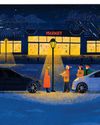Intentar ORO - Gratis
Eye Health Epidemic
Reader's Digest US
|May 2024
What's behind the sharp increase in nearsightedness?

ROUGHLY 42% OF Americans are nearsighted today, compared to 25% in 1971. The World Health Organization (WHO) predicts that about half of the world's population will have myopia, or nearsightedness, by 2050. It's clear that our vision is becoming increasingly blurry, but researchers are only now beginning to understand why.
Generally a childhood phenomenon, myopia happens when the eyeball grows too long from front to back, taking on more of an oval shape versus a sphere. Eyes have a "stop signal" so that they grow proportionally with the head, explains Gregory Schwartz, an associate professor at the Departments of Ophthalmology and Neuroscience at the Feinberg School of Medicine at Northwestern University. However, that signal can be interrupted by genetic and environmental factors, which leads to our eyeballs growing a bit too much, making them too big for the optics (the lens and the cornea, which are responsible for focusing your vision).
The mismatch between the eyeballs and the optics leads to far-off objects looking out of focus. Telltale signs you might have myopia also include headaches, as well as eye strain and tiredness when doing certain activities such as driving or playing sports.
Esta historia es de la edición May 2024 de Reader's Digest US.
Suscríbete a Magzter GOLD para acceder a miles de historias premium seleccionadas y a más de 9000 revistas y periódicos.
¿Ya eres suscriptor? Iniciar sesión
MÁS HISTORIAS DE Reader's Digest US

Reader's Digest US
Joyride
A poacher of rare orchid plants in Florida. An African king who drives a cab in New York City. How people spend a Saturday night in America.
1 min
December 2025 / January 2026

Reader's Digest US
Dog Affirmations
Illustrator Andrea Cáceres uplifts and delights with these picture-book insights into the deepest thoughts of man's best friend.
1 min
December 2025 / January 2026

Reader's Digest US
ROCK BOTTOM
A HIKER SOMEHOW SURVIVED BEING PINNED IN A CREEK UNDER A 700-POUND BOULDER. THEN THE WATER STARTED TO RISE.
11 mins
December 2025 / January 2026

Reader's Digest US
Secret Santa Saves the Day
A stranger keeps the Christmas spirit alive for a little girl
4 mins
December 2025 / January 2026

Reader's Digest US
THE BEST MONEY I EVER SPENT
Deep Pockets - One Christmas, my wife, who seldom wears jewelry, wanted diamond earrings as her gift. I obliged but figured the little box would ruin the surprise, so I bought an inexpensive fleece jacket at a farm supply store and put the earring box in the pocket.
5 mins
December 2025 / January 2026

Reader's Digest US
Rental Family
Starring Brendan Fraser
1 min
December 2025 / January 2026

Reader's Digest US
St. Denis Medical
Starring Allison Tolman
1 min
December 2025 / January 2026
Reader's Digest US
No Drama Llamas
BEING WITH LOVED ones during the holidays is a delight. Getting there is not.
1 min
December 2025 / January 2026

Reader's Digest US
The Christmas Truce of 1914
As World War I raged around them, soldiers facing off along one stretch of the fighting decided to hit pause
6 mins
December 2025 / January 2026

Reader's Digest US
Our Hanukkah Miracle
Christmas takes on new meaning for a Jewish couple
3 mins
December 2025 / January 2026
Listen
Translate
Change font size

